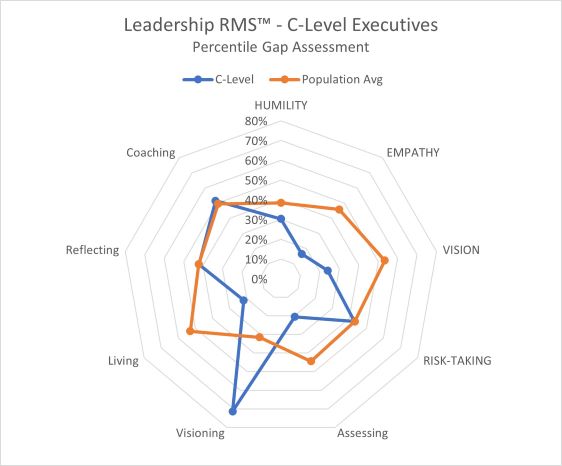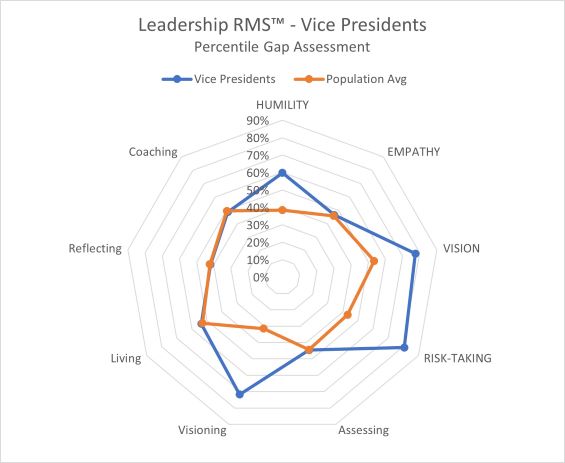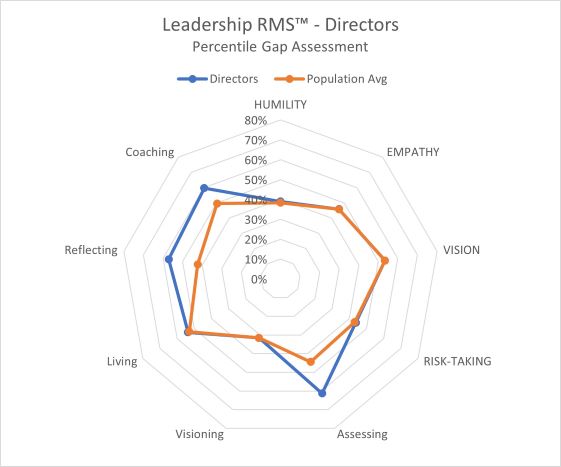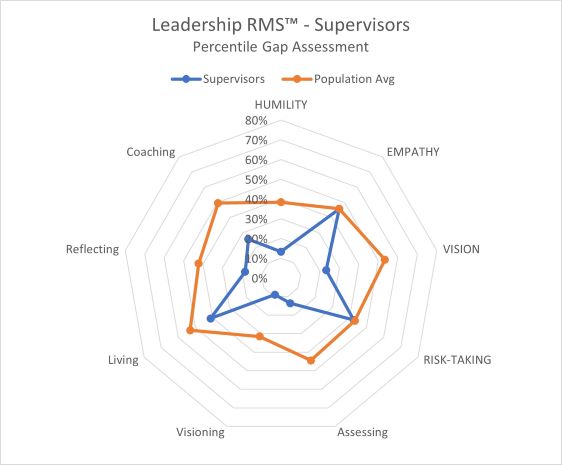LeadershipRMSTM was used to create some profiles of participants at various organization levels. We’ve summarized them on this page to provide a peek into the power of Leadership Analytics RMS. Capitalized dimensions represent the Potential for Leadership with the others representing the Practice of Leadership.
C-Level Executives

In this analysis, we find the C-Level executives below the population average on all dimensions except for Visioning and Coaching (slightly) and only slightly below for Reflecting. Visioning is having a leadership vision that they can articulate at a moment’s notice. From my experience meeting with these executives, most of them have a clearly articulated vision, although at this level, they should all have a vision.
Many are receiving some sort of coaching, but clearly not enough. This probably stems from the fact that as a person rises in an organization, there are fewer people with enough experience to coach and mentor them. That’s why young people are advised to find coaches and mentors early in their careers because that pipeline of valuable advice gets smaller and smaller as they grow in their career.
The other dimensions below the population average are concerning. This could be because at this level, they no longer think about their potential and practice of leadership but behave more on autopilot to some degree. Unfortunately, this doesn’t work as leaders at all levels should continue to focus on their leadership every day.
LeadershipRMSTM Overview | Individual LeadershipRMSTM
Team LeadershipRMSTM | Organization LeadershipRMSTM
Request Additional Information
Vice President Level

In this analysis, we find the Vice Presidents mostly above the population average and only below the average for the Reflecting and Coaching dimensions. This contrasts with the C-Level participants who were below the population average on all but three dimensions, Visioning, Reflecting and Coaching. While the C-Level participants may be on leadership autopilot at this point in their career, the Vice President participants are still aspirational and remain focused on getting to the next level.
The challenge for the VP population is if they are aspirational and trying to reach the C-Level, then they need to focus more on their Reflecting habits and Coaching relationships. Both will make them a better leader. Reflecting is that internal voice that helps the leader examine how they performed in their leadership encounters. Coaching is that external voice that provides feedback on how the leader performed and provides suggestions for future encounters.
Director Level

In this analysis, we find the Directors are at or above the population average on all nine dimensions. They are the only organization level studied that was above average on all of the dimensions. The next closest was the Vice Presidents who were above the average on seven out of nine dimensions. The Directors have embraced their innate leadership qualities (potential, in caps) and use them to maximize their effectiveness. They are also following some aspects of a leadership process (practice) even if they don’t recognize it as such.
The Director results is probably indicative of their aspirations at this point in their careers, which is very similar to the Vice President’s mindset. The Directors though are taking their aspirations to a new level and recognizing the importance of Reflecting and Coaching. If anything, they are at an inflection point in their careers. Their next move could be their most important and set the tone for their long-term goals.
Mentors and coaches are critical for leaders at this stage in their career. After this level, it will become more difficult to find and build a relationship with a mentor who can add value to their career. Although we combine coaches and mentors in the Coaching dimension, they serve different purposes and a leader needs both for their long-term success.
Most people would conclude that the Directors population are on the right track and nothing needs to be done to improve their leadership. We would argue that statement is only partially true. Directors have had a taste of leading larger teams and most probably want more. It is at this point in their career that they should be encouraged and helped to fully embrace the nuances of their leadership potential and formalize their regular practice of leadership.
LeadershipRMSTM Overview | Individual LeadershipRMSTM
Team LeadershipRMSTM | Organization LeadershipRMSTM
Request Additional Information
Supervisor Level

In this analysis, we find the Supervisors are below the population average on all nine dimensions. These leaders are not embracing or even knowing their innate qualities that will define their leadership potential. They are also not practicing any form of leadership process. Supervisors are still very early in their leadership career. They most likely performed well enough as a Manager and were promoted to Supervisor, with little regard for their leadership abilities. Organizations must recognize this critical point in their career and provide them with the leadership development support they need. Additionally, by using a tool such as the Leadership IMPACT Assessment, the organization can better assess how well they will perform as a leader going forward and identify areas for improvement.


